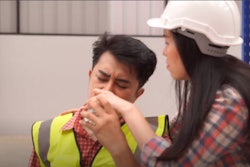
Ensuring the workers on your jobsites stay safe during the hot weather months means understanding and managing the risks. In an article written for Safeopedia.com, Jessica Barrett, Honeywell Industrial Safety, took a look at some of the top summer safety hazards and how to address them.
Hazard #1: Fatigue
“Fatigue is more than just feeling a little tired – it's a form of impairment,” Barrett writes. “It can reduce mental and physical functioning, affect judgment and concentration, slow reaction time, and lower motivation.”
Such impairment can place workers at greater risk. Barrett recommends you:
- Avoid having workers in direct sun for long periods and make a shady area available for breaks.
- Provide plenty of fluids and perhaps salty snacks to replenish sodium lost to sweat.
- Encourage use or provide hats to protect workers from the sun.
Reduce Construction Workplace Injuries with Wearable Technology
Hazard #2: Heat-related Illnesses
According to Barrett, "heat stress" is a blanket term for a handful of heat-related illnesses, from heat rash to heat stroke, with varying degrees of severity.
To minimize the risks of workers developing heat stress, John Meola, safety director, Pillar Engineers, advises, "In extreme heat (90° F and above), consider rescheduling to work in cooler parts of the day. Can this job be done at night, or can you modify a shift for earlier morning starts?"
He adds, "Whenever possible, configure work in shaded areas, and use canopies or umbrellas to avoid direct sun exposures, even if only for intermittent protection."
Barrett also advises:
- Reducing physical demands in periods of high temperature and humidity levels
- Cycling workers in and out for physically demanding tasks
- Providing PPE appropriate to weather conditions
- Mandating rest periods in shaded areas
- Providing and encouraging use of hydrating fluids
- Training employees to recognize the symptoms of heat-related illnesses and how to take appropriate action
"They need to know that strange behavior may be a sign of heat-related illness and to take some early steps to intervene," says Meola. "Early symptoms include lethargy, disorientation, stumbling, dropping tools, slurred speech or unresponsiveness."
3 Essentials Define Effective Heat Illness Prevention Plan
18 Tips to Stay Cool on the Jobsite in the Summer Heat
Hazard #3: Dehydration
“Extreme heat and hard physical labor can increase the rate at which our bodies lose water, depleting our hydration levels and posing a health and safety risk,” Barrett cautions.
Make sure hydrating fluids, and water in particular, are readily available and that workers drink it regularly.
"Water is arguably the best hydrating beverage, but it’s tasteless and boring. Enter the electrolytic beverages: Gatorade, Squincher, etc. Even a slice of lemon will add some taste to a cooler," says Meola, which can encourage more regular consumption.
10 Hot-Weather Safety Tips for Construction
Hazard #4: Sun Exposure
Direct exposure to the and its intense UV rays poses its own hazard to workers. The main short-term effect from extended sun exposure is sunburns; long term, this can increase the risk of developing skin cancer. Sun exposure also contributes to fatigue and dehydration.
Workers should keep exposed skin covered as much as possible, including the ears and back of the neck. Sunscreen should be worn on any skin still exposed. Those with fair skin should be checked for unusual moles or spots on a regular basis.
12 Tips to Survive Another "Nuclear Summer"
Hazard #5: Road Construction Work
According to NIOSH, nearly 100 workers are killed and more than 20,000 injured in work zones every year, Barrett points out. She advises:
- Clearly identifying works areas and using barriers to keep traffic out of work zones, plus lowering speed limits
- Ensuring all workers wear appropriate PPE for the job, including hi-vis gear
- Educating workers about traffic-related hazards and protection plans
"Safety vests are a must, safety meetings at the jobsite are essential when starting a new job – as are daily safety reminders for longer projects," comments Allan Heydorn, editor, Pavement Maintenance & Reconstruction. "And remind workers that complacency can lead to injury."




















